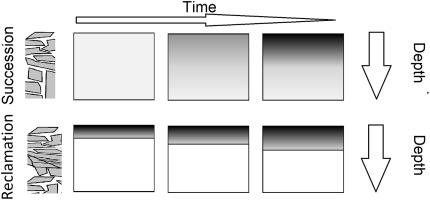Global Ecology and Conservation ( IF 3.5 ) Pub Date : 2020-06-20 , DOI: 10.1016/j.gecco.2020.e01165 Jabbar Moradi , Kingsley John , Fabio Vicentini , Hana Veselá , Jakub Vicena , Masoud M. Ardestani , Jan Frouz

|
Vertical distribution of soil biota is not well understood. Here we studied the development of vertical distribution of soil chemical and biological properties in two post-mining chronosequnces in heaps after open cast coal mining, one left to succession (sites 20, 35 and 60 years old) and one reclaimed by levelling and Alder (Alnus glutinosa and Alnus incana) afforestation (sites 10, 25, 40, and 60 years old) near Sokolov, Czechia. When spoil material is compacted during levelling and afforestation, as in reclaimed sites, the effect of time in soil biota development was less important than in spontaneous succession where no compaction occurs. Soil depth was a stronger explanatory factor in explaining the soil microbial biomass variations under reclamation regimes while comparatively less strong under spontaneous succession which points at the impact of spoil compaction on vertical development of organisms. Spontaneous succession encourages a more diverse and dynamic vertical, as well as horizontal, faunal community development, especially across time. Breaking down fauna into ecological subgroups, time was more of an important factor for fauna active below ground (endogeic), than for surface-dwelling fauna likely due to further soil profile development by time. Calculated depth in which 90 % individuals occur shows that considering only the depth of 0-10 cm overlooks a substantial part of some faunal groups (e.g. Pauropoda and Symphylan) that are abundant in deeper layers. Soil depth is also more of a strong predictor of soil biota than soil C content, indicating that the population decrease in soil biota community with depth cannot be explained only by decreasing organic matter content.
中文翻译:

两种相反的采后时间序列在土壤动物和微生物群落的垂直分布上:al木人工林开垦的土地和未开垦的再生土
土壤生物区系的垂直分布尚不清楚。在这里,我们研究了露天煤矿开采后堆中两个采矿后时间序列中土壤化学和生物学特性的垂直分布的发展,其中一个遗留了继承权(20、35和60年的旧址),而另一个则由平整和Alder回收(glut木和inc木)在捷克共和国索科洛夫附近的植树造林区(已有10、25、40和60年的历史)。当在平整和造林期间将土壤材料压实时(如在开垦地中),时间对土壤生物群发育的影响不如没有压实的自然演替中重要。土壤深度是解释开垦条件下土壤微生物生物量变化的更强解释性因素,而自发演替下土壤微生物量的变化相对较小,这说明了土壤压实对生物体垂直发育的影响。自发的继承鼓励垂直和水平的动物群落发展,尤其是跨时间的多样性和动态。将动物分为生态亚类,时间更是导致地下动物活动(内生)的重要因素,可能是由于随时间推移土壤剖面进一步发展而导致的地表动物。计算出的有90%的个体出现的深度表明,仅考虑0-10 cm的深度就可以忽略一些深层丰富的动物群(例如,Pauropoda和Symphylan)的大部分。土壤深度也比土壤C含量更能作为土壤生物区系的有力预测指标,这表明土壤生物区系随着深度的增加而减少的现象不能仅通过减少有机质含量来解释。







































 京公网安备 11010802027423号
京公网安备 11010802027423号